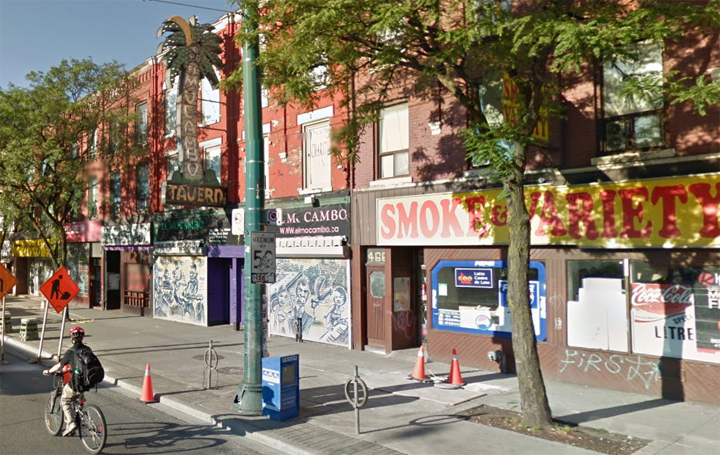Back in November 2014, it looked like the El Mocambo, one of the world’s great rock’n’roll dive bars, was finished. After passing through a couple of owners since 2001 — including time in the hands of a missionary — the club had apparently run its course and was slated to close after a final show on Nov. 6, 2014.

But then, an angel investor.
Dragon’s Den star, entrepreneur and merchant banker Michael Wekerle swooped in at the last second, buying the Elmo for $3.6 million. The club was closed and renovations commenced.
Anyone who has ever done a home reno knows that these things are never completed on time. But the work on the Elmo has seemed never-ending. Why? What’s taking so long?
For the answers, I went to Eddie Kramer, the famous producer and engineer (Jimi Hendrix, Rolling Stones, David Bowie, Eric Clapton, Zeppelin, Santana, etc.) who has been spending an inordinate amount of time in Toronto.
Alan Cross: You have been hanging around Toronto a lot. Why?
Eddie Kramer: I’m here because of a little club called the El Mocambo.
AC: We’ve been hearing many stories and rumours about Mr. Wekerle and the Elmo and what’s being done there. Can you give us any kind of idea of what to expect when this thing finally reopens?
EK: It’s gonna be pretty amaaaaaaazing! We’re getting real close.
AC: Nobody brings in Eddie Kramer unless they’re building a studio.
EK: What’s happened is we’ve taken the old El Mocambo — and we’ve destroyed it all the way down to grade and eight foot below grade. Then we underpinned the whole building and built a new building on the inside. So all that’s left is the facade front and back.
AC: Wekerle bought the building for $3 million and then sunk another 10 into it. Those are the rumours.
EK: Mmm, I can’t really say. … But now we have a brand new facility. The ground floor will be the original bar — the tavern, I guess that’s what it was. Completely redone. Much bigger. More space. But above it when you go up the stairs to the second floor, it used to have 10-foot ceilings, you now have ceilings twenty-six-and-a-half-foot high with a balcony around the top, too. And on the third floor looking down on the stage is my studio.
AC: No kidding.
EK: Mm-hm. And it’s live streaming, it’s 4K cameras — it is certainly going to be the best facility certainly in all of Canada — and probably on the whole east coast.
AC: Were you involved in any of the Rolling Stones recordings there?
EK: Yes, 1977. I had a little truck parked behind the El Mocambo and recorded the Love You Live album there.
AC: Is this the reason? Why did you agree to do this?
AC: What is the purpose of this club going to be?
EK: It’s two venues which are essentially the two best live venues in Toronto — with a recording studio. Why not?
AC: You don’t see a lot of full-featured recording studios anymore. Who’s going to pay for the maintenance, the upkeep, upgrades and the renovations and refurbishments when required? And who can afford one of these things now?
EK: But it’s the content. That’s where it’s at.
AC: So when will it be ready?
EK: Mmm … hopefully soon. You know how it is. When you start a piece of construction with complexity, it takes time. We’re hoping, … fall? It’s complex. It’s a tricky piece of construction. The two rooms are soundproofed. I can record in either room and nothing will go between the two.
AC: When you were digging down, did you find anything?
EK: Some beautiful old Chinese pieces of clay pottery. Very old.
AC: That building dates back to the 1840s.
EK: And we found some old medicine bottles that date back to 1870, 1875. We’ve been told that this could have been part of the underground railroad from America.
What about the famous palm tree sign? The bad news is that the original was just too weathered to be refurbished and re-hung over the sidewalk again. The good news is that it has been cleaned up and cut in half so it can adorn either side of the stage. A new sign — an exact replica but with updated construction and electronics — has been fabricated in a shop in Cambridge, Ont.
What about all the wood from the inside? Salvaged and in the process of being recycled into … something musical. Rumours about a Walhburgers franchise seem unfounded.
Eddie, who has moved to Toronto with his wife to be part of this project, is electric with enthusiasm about the Elmo’s future. And who knows what kind of magnet it may become for the world’s biggest musicians?
Alan Cross is a broadcaster with 102.1 the Edge and a commentator for Global News.






Comments